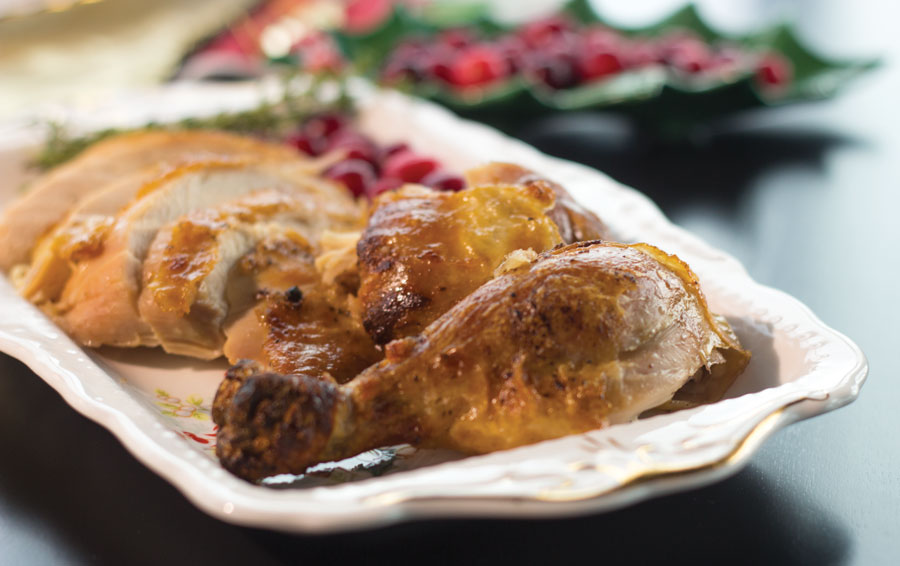Brining is one of those cooking techniques that some shy away from because it sounds complicated, and difficult. But it can be one of the simplest ways to prepare food for consumption. You can brine fruit, vegetables, fish, meat, even cheese. At its most involved there are related techniques like curing and fermenting, which can be challenging. But brining meat for roasting is as simple as it gets.
The short version: get some water, some salt, some meat. Put it all together and you’re essentially done.
Brining adds moisture and flavour to your meat and reduces cooking time. With poultry, particularly turkey, you end up with a much more moist and flavourful bird which is important when dealing with a meat that tends towards being dry and subtly flavoured.
The process dissolves some of the muscle proteins, which allows them to absorb more moisture. It also stops the proteins from contracting too much while cooking so the meat retains that moisture.
Brining properly can decrease total moisture loss by 30 to 40 per cent. But beware—with pork—some stores sell what they call pre-seasoned product. You can take care of this yourself by buying fresh local pork and brining it at home.
This technique works best with lean meats, but the most popular brined meat is, of course, pork belly. Bacon can be brined or dry cured adding salt, sweetness, and other flavours.
And while it’s not a common technique, brining red meats is not unheard of.
It some instances brining can edge into the territory of preserving, particularly in the case of fish. Gravlax, or dry brined salmon, borders on curing. Gravlax was traditionally made by fishers in Sweden. It involved salting and then burying the fish in the sand near the high tide mark. The fish would come out salty and slightly fermented. Modern gravlax skips the fermenting part.
This type of dry brining works best with oily or fatty fish but can be used with others. The leaner the fish the less curing time needed.
Chicken/Turkey Brine
1 gallon water
1 cup salt (11/2 cups kosher or coarse salt)
1/2 cup white vinegar
3 tbsp brown sugar
1 tbsp pickling spice
1 tsp black pepper
1 tsp allspice
1 tsp garlic powder
1 tsp tarragon
1. Dissolve salt and brown sugar in water in a large pot. Add vinegar and spices. Bring to a boil. Allow to cool.
2. Pour cooled brine over poultry making sure to submerged completely. Refrigerate for 1 hour per pound of poultry.
3. Rinse all the brine from the chicken or turkey before cooking. Otherwise, there will be a salty flavor.
4. Season and roast as per your favourite recipe.
Standard Brine (Pork)
1/4 cup plus 2 tbsp honey
12 bay leaves
3 large rosemary sprigs
1/2 bunch thyme
1/2 bunch flat-leaf parsley
1/2 cup garlic cloves, crushed, papery skin left on
2 tbsp black peppercorns
1 cup kosher salt, or coarse sea salt
8 cups water
1. Combine all of the ingredients in a large pot, cover, and bring to a boil. Cook for 1 minute, stirring to dissolve the salt, then remove from the heat and let cool completely.
2. Submerge meat in brine, cover and refrigerate for at least 8 hours and up to 3 days.
3. Remove from brine, rinse and dry.
4. Season and roast as per your favourite recipe.
Salmon Gravlax
2 sides salmon, skin on, pin bones removed
3 cups coarse sea salt
3 cups brown sugar
1 large bunch of fresh dill, chopped or 4 tbsp dry dill
1. Mix salt, sugar and dill together in a bowl.
2. Sprinkle half of the salt mixture in the bottom of a glass baking pan or plastic rectangular container. The container should be the full length of the fillet.
3. Place fillets skin-side up in the container and press down.
4. Completely cover the fillets with the remaining salt mixture.
5. Wrap or cover container tightly and let cure in the refrigerator for at least 24 hours, up to 48 hours.
6. Remove fillets from brine and rinse well in cold water.
7. Dry fillets completely and store in fridge wrapped in cling wrap until ready to serve. The salmon may also be frozen at this time.
8. When ready to serve, use a sharp knife to slice the fillet thinly, working from the large end and slicing forward.
Can be served with sour cream or cream cheese, capers, thin sliced sweet onion, on thin-sliced toasted bread.
- THE SALTY Chef with Chef Stephen Hunter - October 1, 2018
- THE SALTY CHEF-BOUILLABAISSE - September 1, 2018
- THE SALTY CHEF – with Chef Stephen Hunter - August 1, 2018
- THE SALTY CHEF with Chef Stephen Hunter - July 1, 2018
- THE SALTY Chef with Chef Stephen Hunter - June 1, 2018
- THE SALTY CHEF-BISQUE - May 1, 2018
- THE SALTY CHEF-THE GOOD BURGER - March 31, 2018
- THE SALTY CHEF-with Guest Chef Sarah Forrester Wendt - March 1, 2018
- THE SALTY CHEF – with Chef Stephen Hunter - February 1, 2018
- THE SALTY CHEF with Chef Stephen Hunter - January 1, 2018


